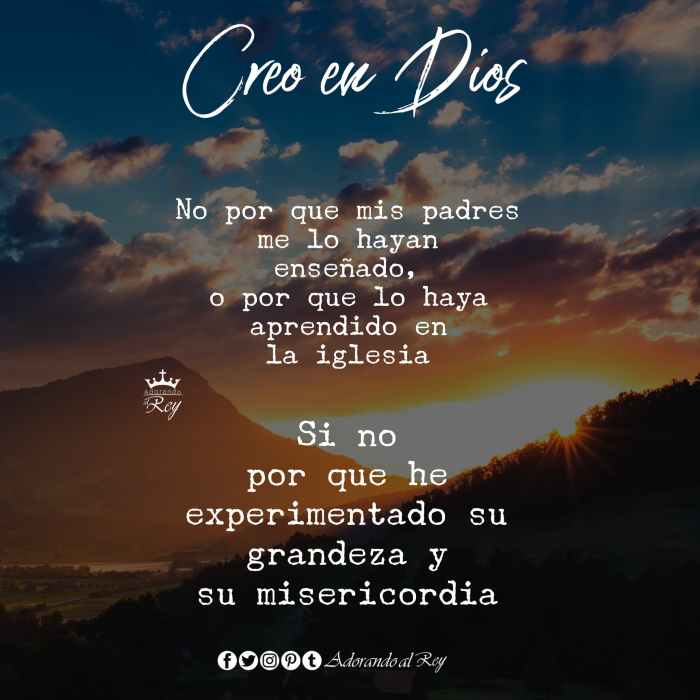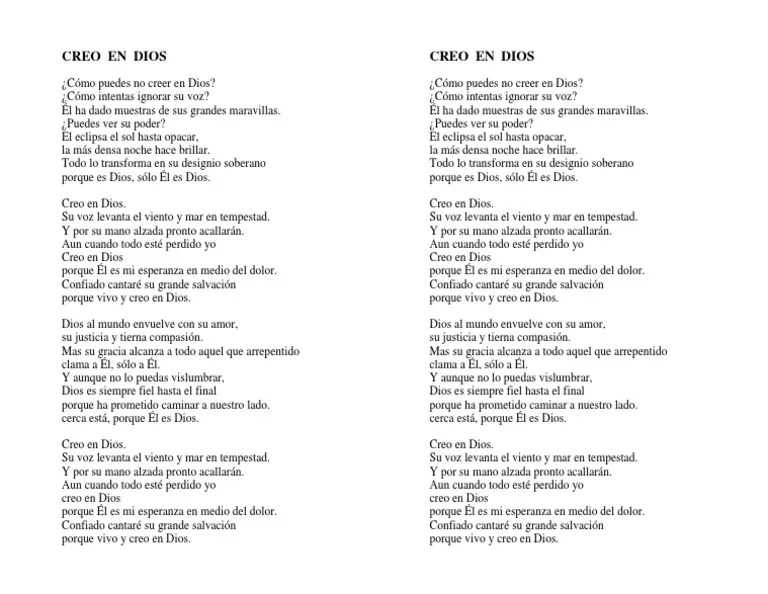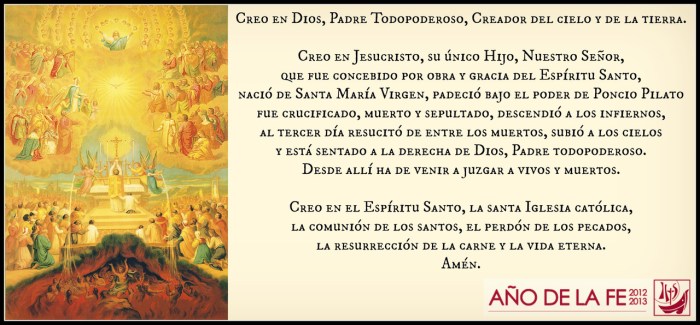Creo en un solo dios prayer – At the heart of Christian liturgy lies the Credo in unum Deum prayer, a declaration of faith that has resonated through centuries. Its historical significance, profound symbolism, and theological implications have shaped Christian thought and practice, leaving an enduring legacy in art, music, and literature.
The prayer’s structure and imagery reflect Christian beliefs about God’s nature, while its use in various denominations highlights its ecumenical significance. This exploration of the Credo in unum Deum prayer will delve into its historical, theological, and cultural impact, shedding light on its enduring importance in Christian spirituality.
Credo in unum Deum Prayer

The Credo in unum Deum, also known as the Nicene Creed, is a Christian creed that is used in many different denominations. It is a statement of faith that summarizes the basic beliefs of Christianity. The creed was originally written in Greek in the 4th century AD, and it has been translated into many different languages.
Original Latin Text and English Translation
Credo in unum Deum,Patrem omnipotentem, factorem caeli et terrae, visibilium omnium et invisibilium.
I believe in one God, the Father almighty, maker of heaven and earth, of all things visible and invisible.
Role in Christian Liturgy and Use in Various Denominations
The Credo in unum Deumis used in many different Christian denominations, including the Catholic Church, the Eastern Orthodox Church, and the Protestant churches. It is typically recited during Mass or other worship services. The creed is a reminder of the basic beliefs of Christianity, and it helps to unite Christians from different denominations.
Structure and Symbolism

The “Creo en un solo Dios” prayer is structured as a creed, a statement of belief. It consists of three sections:
- A profession of faith in one God, the Father, the Creator of all.
- A declaration of belief in Jesus Christ, the Son of God, who was crucified, died, and rose from the dead.
- An affirmation of belief in the Holy Spirit, the giver of life.
Throughout the prayer, there is rich symbolism and imagery. For example, God is referred to as the “Father,” which evokes images of a loving and protective parent. Jesus is called the “Lamb of God,” a symbol of sacrifice and redemption.
The Holy Spirit is represented by the dove, a symbol of peace and purity.These symbols and images reflect Christian beliefs about God. God is seen as a loving Father who created the world and all that is in it. Jesus is seen as the savior who died for the sins of humanity and rose from the dead to give eternal life.
The Holy Spirit is seen as the source of life and power for Christians.
Theological Interpretation

The “Creo en un solo dios” prayer holds significant theological implications, particularly regarding monotheism and the understanding of God’s nature and attributes within Christianity.
Monotheism
The prayer’s opening line, “Creo en un solo dios,” establishes the core principle of monotheism, the belief in one God. This is a fundamental tenet of Christianity, contrasting with polytheistic beliefs that recognize multiple deities. The prayer emphasizes the singularity and exclusivity of God, acknowledging no other divine beings as worthy of worship.
Nature and Attributes of God
The prayer further expounds on God’s nature and attributes. It describes God as “Padre Todopoderoso, Creador del cielo y de la tierra,” highlighting God’s omnipotence and role as the creator of all things. Additionally, the prayer acknowledges God’s role as “Señor nuestro,” emphasizing God’s authority and sovereignty over all creation.
Comparative Analysis

The Credo in unum Deum prayer shares similarities and differences with other Christian prayers in language, structure, and theological emphasis. These comparisons shed light on the development of Christian prayer.
Language
The Credo in unum Deum prayer uses formal, liturgical language, similar to other early Christian prayers. However, it is more concise and structured than many later prayers, which tend to be more elaborate and personal.
Structure
The Credo in unum Deum prayer follows a tripartite structure, common in early Christian prayers. It begins with an invocation to God, followed by a statement of belief, and concludes with a doxology. This structure provides a clear and organized framework for expressing the central tenets of the Christian faith.
Theological Emphasis
The Credo in unum Deum prayer emphasizes the unity and Trinity of God, a core belief in Christianity. It also affirms the divinity of Jesus Christ and the Holy Spirit. This emphasis reflects the central theological concerns of the early Church, which focused on establishing the nature of God and the relationship between God and humanity.
Creo en un solo dios prayer is a powerful prayer that can help you connect with your faith. It’s a simple prayer, but it can have a profound impact on your life. If you’re looking for a way to deepen your connection with God, I encourage you to learn more about the creo en un solo dios prayer.
You can find more information about it online, or you can talk to your priest or pastor. The prayer has been around for centuries, and it’s helped countless people find peace and comfort in their lives. Like Miss Furr and Miss Skeene , who found solace in their faith during a difficult time, the creo en un solo dios prayer can provide you with strength and guidance on your own journey.
Impact and Influence

The Credo in unum Deum prayer has had a profound impact on Christian thought and practice throughout history. Its influence can be seen in various aspects of Christian life, including theology, liturgy, art, music, and literature.
In terms of theology, the prayer has served as a concise summary of the core beliefs of Christianity. It has been used to teach and catechize believers, helping them to understand and articulate their faith. The prayer has also been used in theological debates and controversies, providing a common ground for discussion and resolution.
Art and Music
The Credo in unum Deum prayer has been a popular subject for artists and musicians throughout the centuries. In art, the prayer has been depicted in various forms, including paintings, sculptures, and mosaics. In music, the prayer has been set to music by many composers, including Josquin des Prez, Palestrina, and Bach.
Contemporary Christian Worship and Spirituality, Creo en un solo dios prayer
The Credo in unum Deum prayer continues to play a significant role in contemporary Christian worship and spirituality. It is recited in many Christian churches during worship services, and it is often used as a devotional prayer by individual Christians.
Questions and Answers: Creo En Un Solo Dios Prayer
What is the historical significance of the Credo in unum Deum prayer?
The prayer is believed to have originated in the early centuries of Christianity, possibly as early as the 2nd century. It was formalized during the Council of Nicaea in 325 AD and has since become a central part of Christian liturgy.
What is the structure of the Credo in unum Deum prayer?
The prayer is divided into three sections: a statement of belief in one God, a statement of belief in Jesus Christ as the Son of God, and a statement of belief in the Holy Spirit.
What are the theological implications of the Credo in unum Deum prayer?
The prayer affirms the Christian belief in monotheism, the existence of one God. It also affirms the divinity of Jesus Christ and the Holy Spirit, as well as the Trinity.